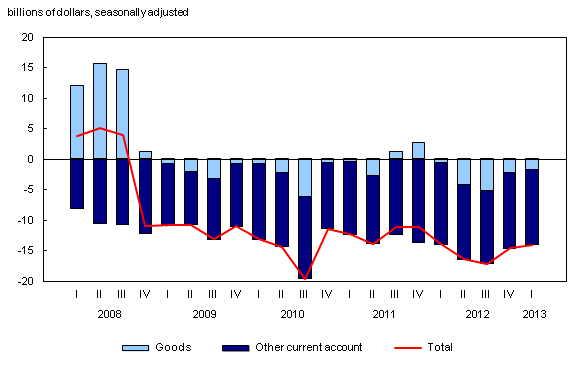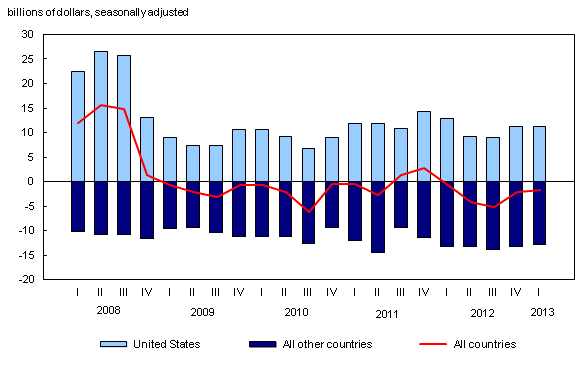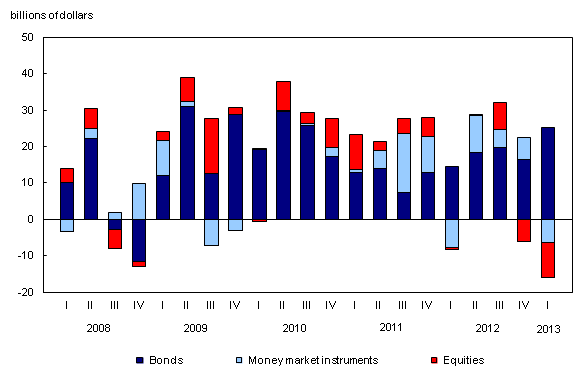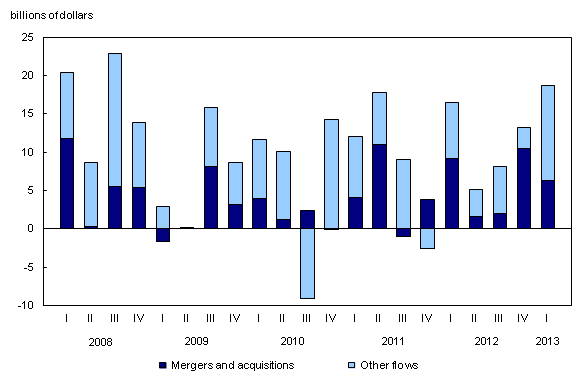Canada's balance of international payments, first quarter 2013
Archived Content
Information identified as archived is provided for reference, research or recordkeeping purposes. It is not subject to the Government of Canada Web Standards and has not been altered or updated since it was archived. Please "contact us" to request a format other than those available.
Released: 2013-05-30
Canada's current account deficit (on a seasonally adjusted basis) narrowed $0.5 billion to $14.1 billion in the first quarter. This change largely reflected lower deficits on trade in goods and services.
In the financial account (unadjusted for seasonal variation), foreign portfolio and direct investors both supplied funds to the Canadian economy in the first quarter. Investment from abroad in the form of securities focused on Canadian bonds, while foreign direct investment in Canada reached the highest level in more than four years.
Current account
Deficit on trade in goods narrows
The deficit on trade in goods declined $0.4 billion in the first quarter to $1.7 billion. Both exports and imports strengthened in the quarter, with exports recording a larger increase. The goods surplus with the United States remained at $11.2 billion, reflecting corresponding increases in both exports and imports.
Total exports of goods were up $2.7 billion to $118.0 billion in the first quarter, with increases widespread across commodities. Energy products were up $0.9 billion, led by record volumes of crude petroleum. Consumer goods increased $0.8 billion on higher exports of food products. Metal and mineral products advanced $0.7 billion, largely reflecting higher volumes of precious metals. Chemical products were up $0.6 billion. These gains were dampened by automotive products, which declined $1.1 billion on lower volumes of cars.
Total imports of goods increased $2.3 billion to $119.7 billion in the first quarter. As with exports, several major categories strengthened. Metal ores and non metallic minerals, supported by higher volumes, grew $0.6 billion. Consumer goods advanced by the same amount. This activity was partly offset by energy products on reduced volumes of crude petroleum, as well as by metal and mineral products on lower volumes of precious metals.
Trade in services deficit edges down
The deficit on trade in services was reduced by $0.2 billion in the first quarter to $5.8 billion. Lower payments on trade in commercial services and higher receipts on transportation services accounted for most of the changes. The travel deficit remained at $4.3 billion in the quarter. While Canadian travellers increased their expenditures in the United States, they cut back on spending on trips overseas.
Investment income deficit contracts
The deficit on investment income decreased $0.2 billion in the first quarter to $4.9 billion. Earnings of Canadian direct investors and foreign direct investors were both down by the same amount during the quarter. Canadian income on foreign securities edged up $0.1 billion, on higher interest and dividends. Income paid to foreign investors on their holdings of Canadian securities was unchanged, as larger payments of interest were offset by smaller dividends.
Financial account
Foreign purchases of Canadian securities focus on bonds
Non-resident investors acquired $9.3 billion of Canadian securities in the first quarter, the lowest such investment in a year. Acquisitions were focused in Canadian bonds, as foreign holdings of money market instruments and equities were down in the quarter.
Foreign acquisitions of Canadian bonds were $25.2 billion, the highest since the third quarter of 2010. This activity was led by secondary market purchases of government and government business enterprise bonds. New issues of private corporate bonds also contributed to the inflows, though these transactions were down from the previous quarter.
Foreign investors withdrew $6.4 billion from the Canadian money market, following three quarters of sizable investments. The divestment was all in government paper, mainly federal Treasury bills on higher retirements of these instruments. Canadian short-term interest rates were up in the first quarter and long-term rates were down.
Non-resident holdings of Canadian equities were down by $9.5 billion. The reduction was mostly attributable to cross-border mergers and acquisitions, as foreign portfolio investors rendered their Canadian shares to foreign direct investors. Non-resident investors' purchases of $2.5 billion on the secondary market moderated the overall divestment in Canadian stocks over the quarter. The Canadian stock market advanced 2.5% in the first quarter.
Canadian acquisitions of foreign securities slow
Canadian investors added $7.0 billion of foreign securities to their portfolios in the first quarter, down from $17.0 billion in the previous quarter. They acquired both equity and debt securities, although acquisitions of bonds slowed. This quarter marked the 13th straight quarterly Canadian investment in foreign securities.
Canadians purchased $4.5 billion of foreign stocks, led by pension funds, with two-thirds of the acquisitions in US equities. The remainder of the activity in non-US stocks was concentrated in Asian markets. US stock prices increased 10% in the first quarter, while the Japanese stock market posted strong gains for a second straight quarter.
Canadian investors acquired $2.4 billion of foreign bonds, compared with $13.0 billion in the fourth quarter of 2012. This reflected a reduction in Canadian holdings of US government bonds in the first quarter. Nevertheless, Canadians have invested in foreign bonds for four straight quarters, more typical of activity prior to the onset of the global credit crisis in 2007.
Foreign direct investment in Canada outpaces Canadian direct investment abroad
Foreign direct investment in Canada reached $18.6 billion in the first quarter, the highest investment since the third quarter of 2008. Funds injected into existing Canadian subsidiaries strengthened in the quarter, while direct investment net inflows from cross-border mergers and acquisitions slowed. Manufacturing as well as the finance and insurance sectors received the bulk of the investment from abroad.
Canadian direct investors increased their foreign assets by $6.5 billion, mainly in the United States. Activity was down from $15.4 billion in the fourth quarter of 2012, as cross-border merger and acquisition flows were at their lowest in nearly two years. Undistributed earnings from operations of foreign subsidiaries were also lower in the quarter.
Note to readers
Annual and quarterly data have been revised for the reference years 2009 to 2012. This is in keeping with the general policy to revise national accounts statistics at the time of the first quarter data release. In general, the revisions reflect more current sources of information coming from annual surveys and administrative data.
The balance of international payments covers all economic transactions between Canadian residents and non-residents in three accounts: the current account, the capital account, and the financial account.
The current account covers transactions in goods, services, compensation of employees, investment income and current transfers.
The current account data in this release are seasonally adjusted. For more information on seasonal adjustment, see Seasonal adjustment and identifying economic trends.
The capital account covers capital transfers and transactions in non-produced non-financial assets.
The financial account comprises transactions in financial assets and liabilities.
In principle, a net lending (+) / net borrowing (-) derived from the sum of the current and capital accounts corresponds to a net lending (+) / net borrowing (-) derived from the financial account. In practice, as data are compiled from multiple sources, this is rarely the case and gives rise to measurement error. The discrepancy (net errors and omissions) is the unobserved net inflow or outflow.
For more information about the balance of payments, consult the "Frequently asked questions" section in the National economic accounts module of our website. The module also presents the most recent balance of payments statistics.
The balance of international payments data for the second quarter will be released on August 29.
Contact information
For more information, contact us (toll-free 1-800-263-1136; infostats@statcan.gc.ca).
To enquire about the concepts, methods or data quality of this release, contact Denis Caron (613-951-1861; denis.caron@statcan.gc.ca), International Accounts and Statistics Division.
- Date modified:





